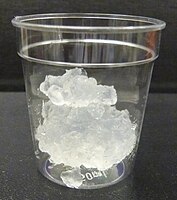
Photo from wikipedia
The present work elucidates achieving superior Cu(II) adsorption capacity using a facile protocol and a biodegradable material. Copper is one of the most prevalent metals used in industries, which creates… Click to show full abstract
The present work elucidates achieving superior Cu(II) adsorption capacity using a facile protocol and a biodegradable material. Copper is one of the most prevalent metals used in industries, which creates severe health effects to the human and aquatic lives when present in excess. Cellulose sponge (CS) used as kitchen wipe was chosen and amine functionalities were introduced on it using ethylenediamine. Potentiality of the amine functionalized cellulose sponge (AF-CS) in Cu(II) removal is investigated for the first time. The batch adsorption parameters were optimized and various nonlinear kinetic and isotherm models were elaborately studied. The adsorption using CS and AF-CS behaved under a pseudo-second-order model and followed chemisorption. The maximum adsorption capacity values using AF-CS and CS from the Langmuir isotherm model were calculated to be 596.96 mg/g and 230.63 mg/g, respectively. Thence, AF-CS possesses proportionately higher adsorption capacity in comparison with CS due to the insertion of -NH2 groups. Further, the mechanism involved in the adsorption process was explored in detail through FESEM, FT-IR, FT-Raman and TGA analysis. The AF-CS sponge was stable on repeated use and retained 90% efficiency at the end of the 10th cycle. A highly effective, easily recyclable, biodegradable and cost-effective adsorbent has been synthesized possessing an extraordinarily high adsorption capacity towards Cu(II) ions.
Journal Title: International journal of biological macromolecules
Year Published: 2020
Link to full text (if available)
Share on Social Media: Sign Up to like & get
recommendations!